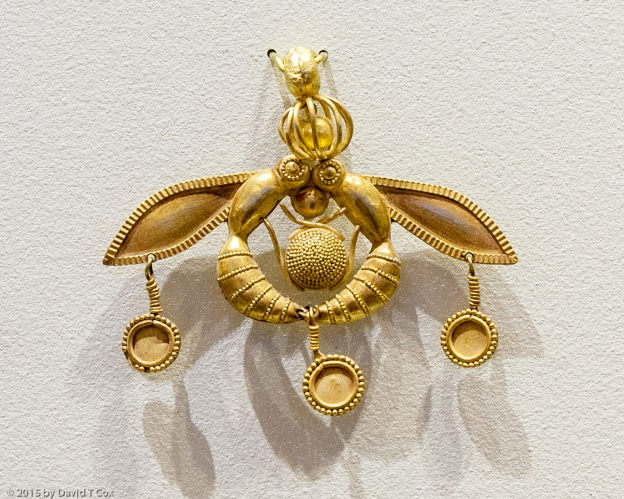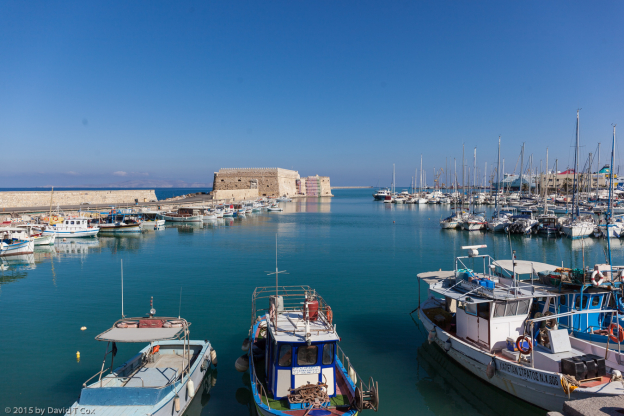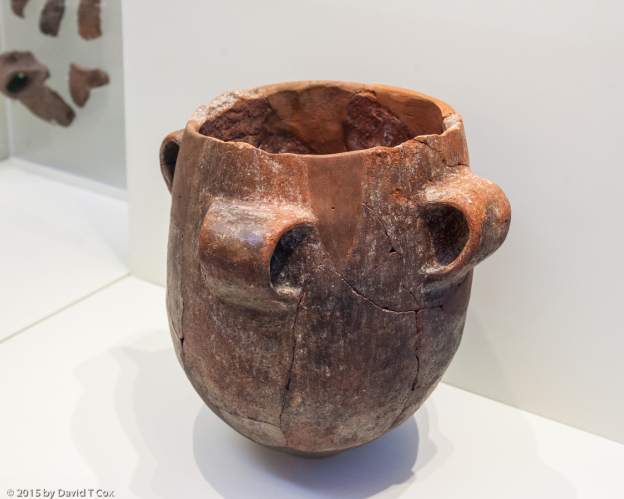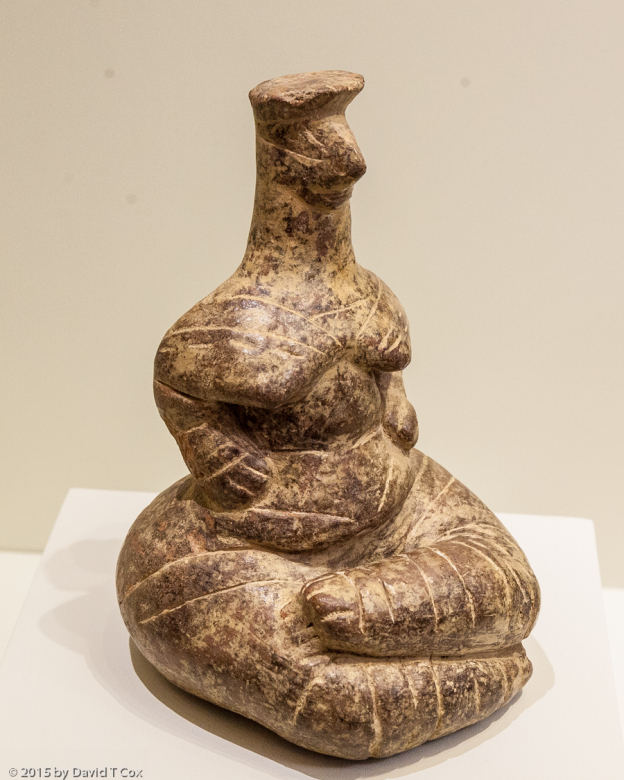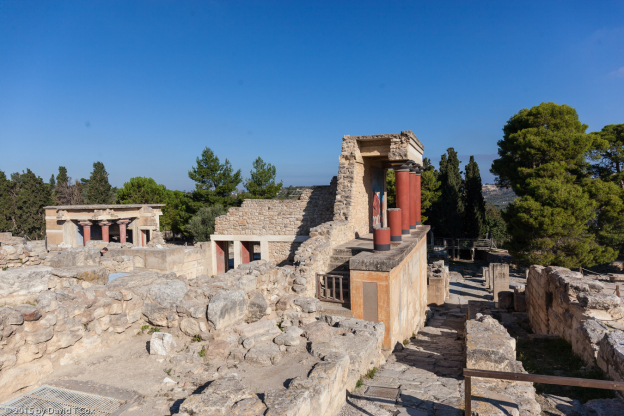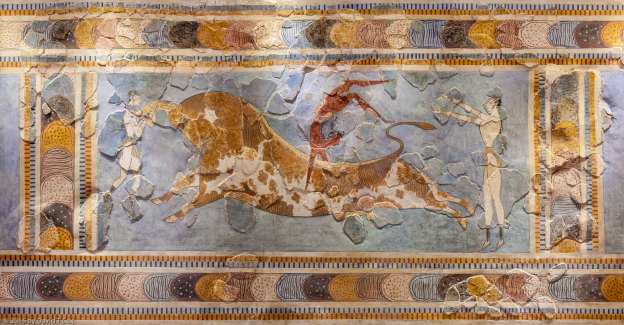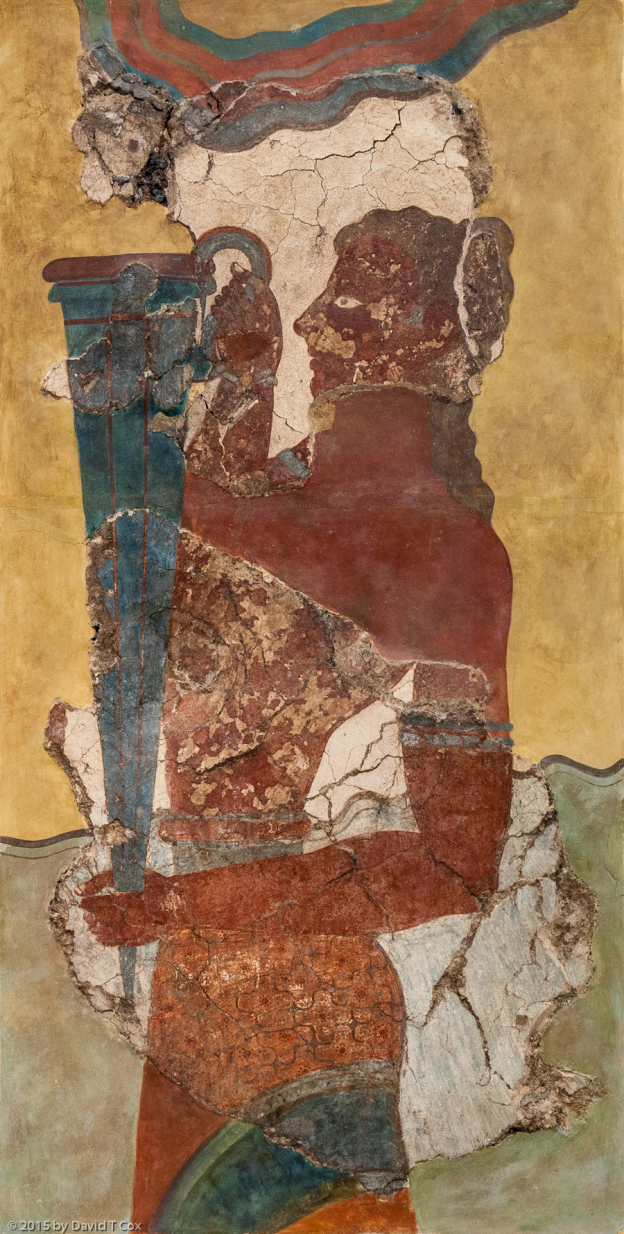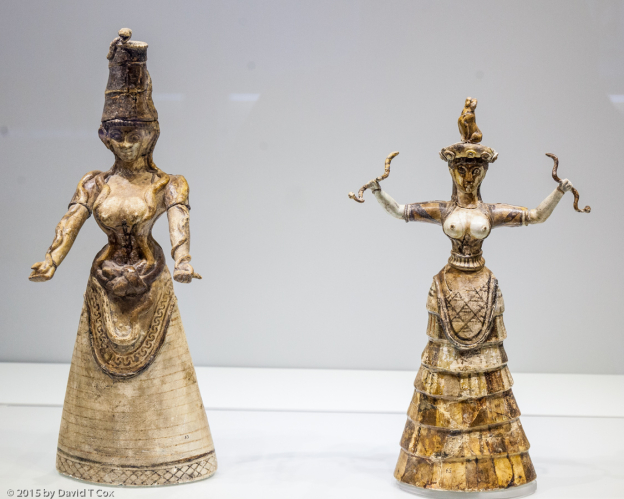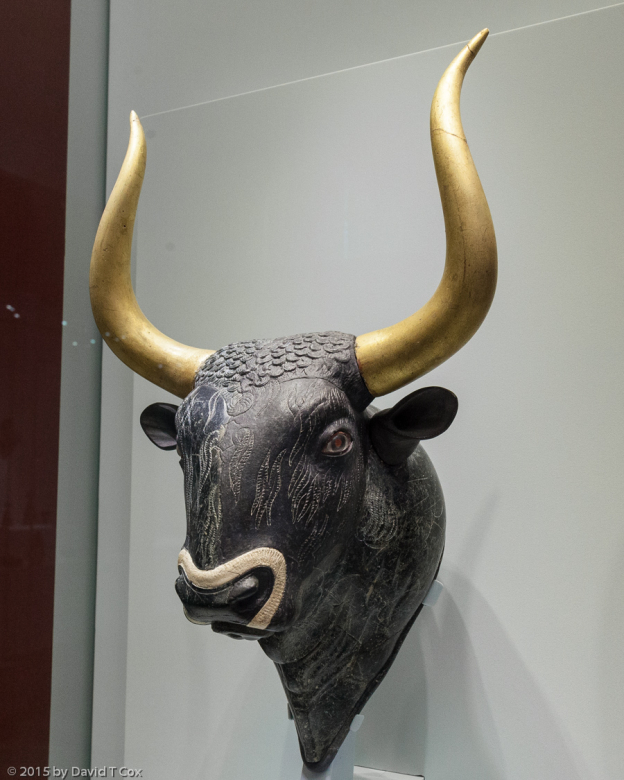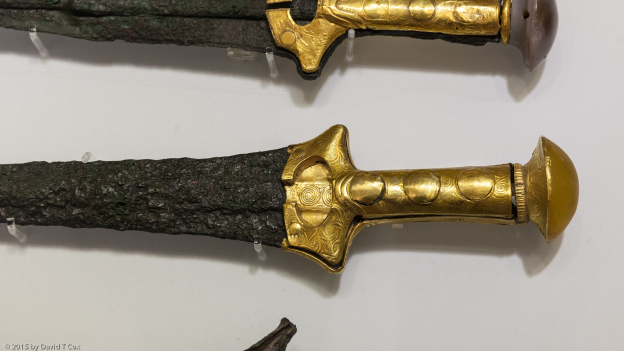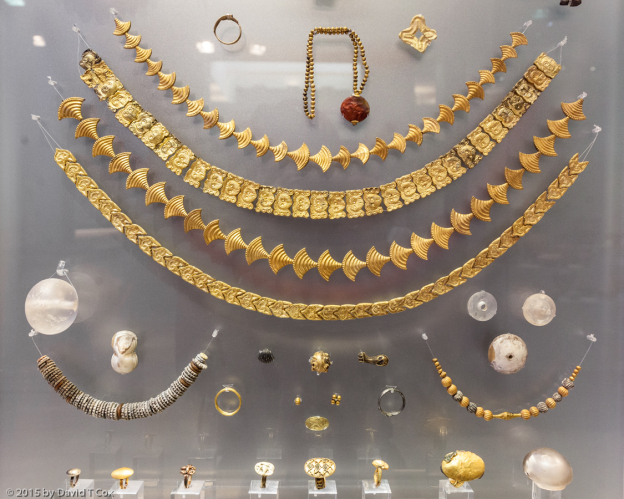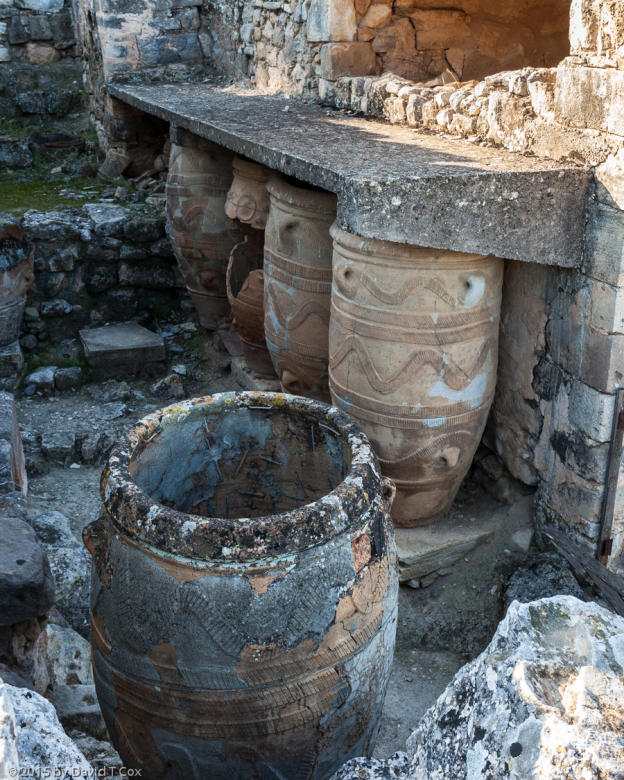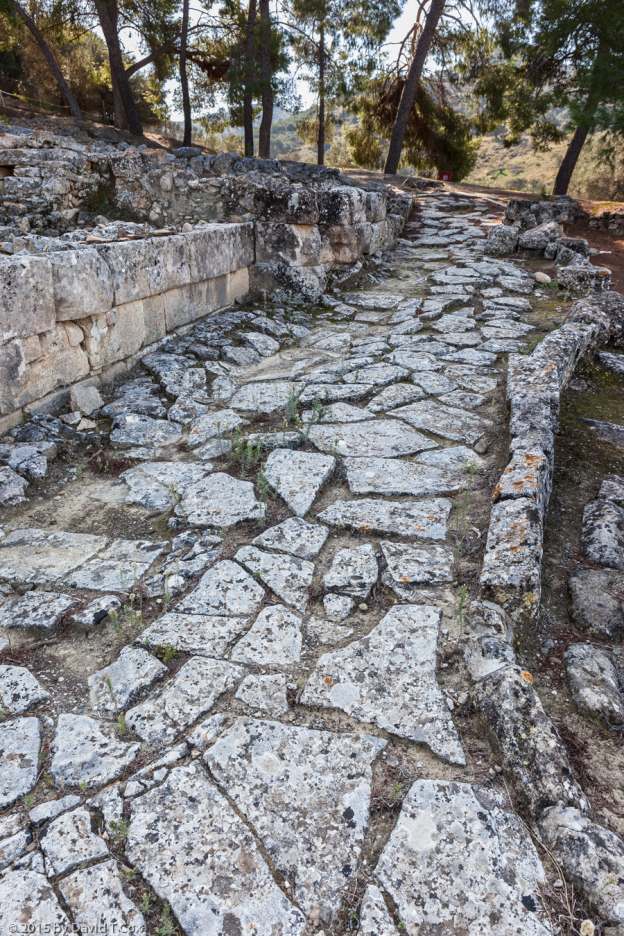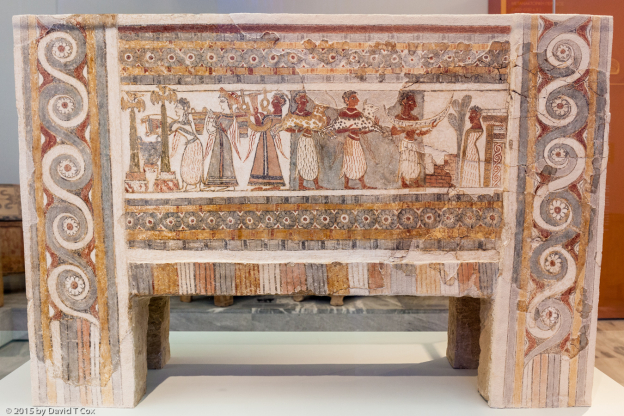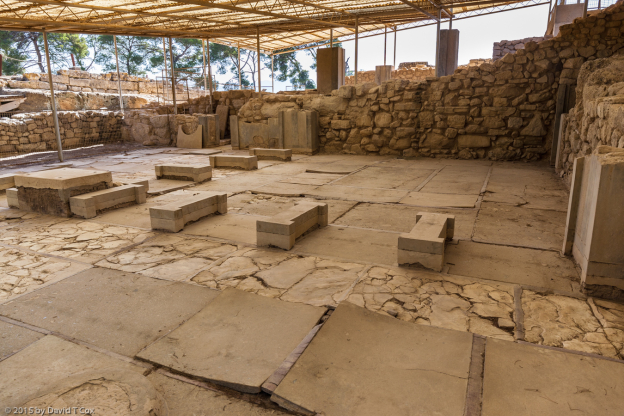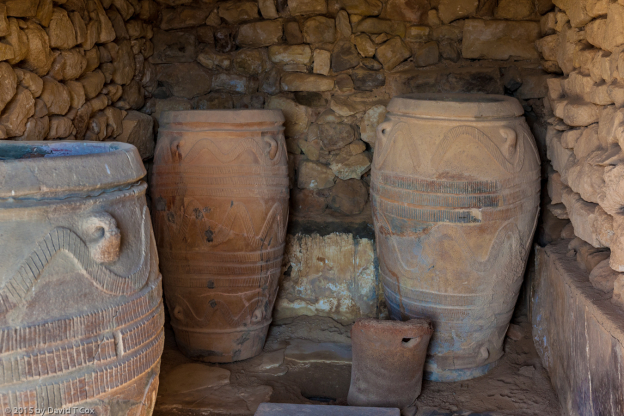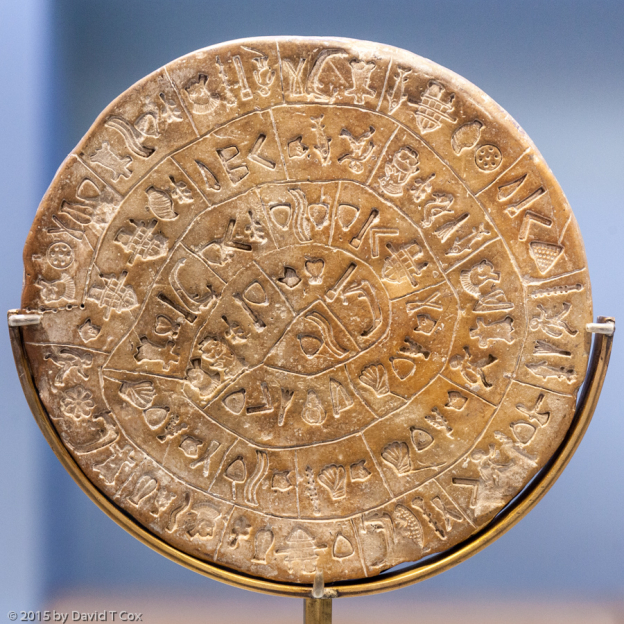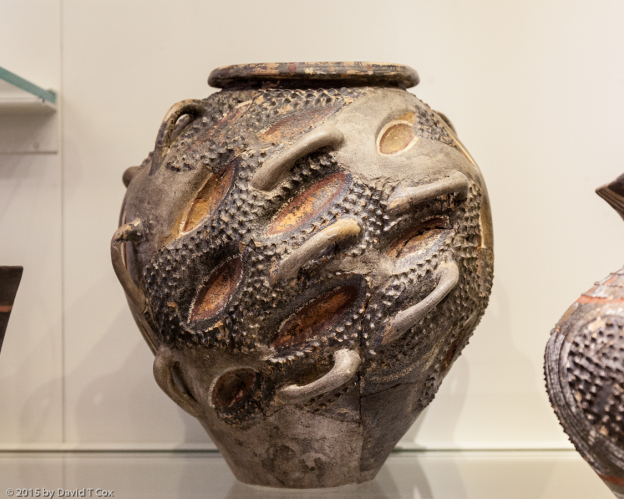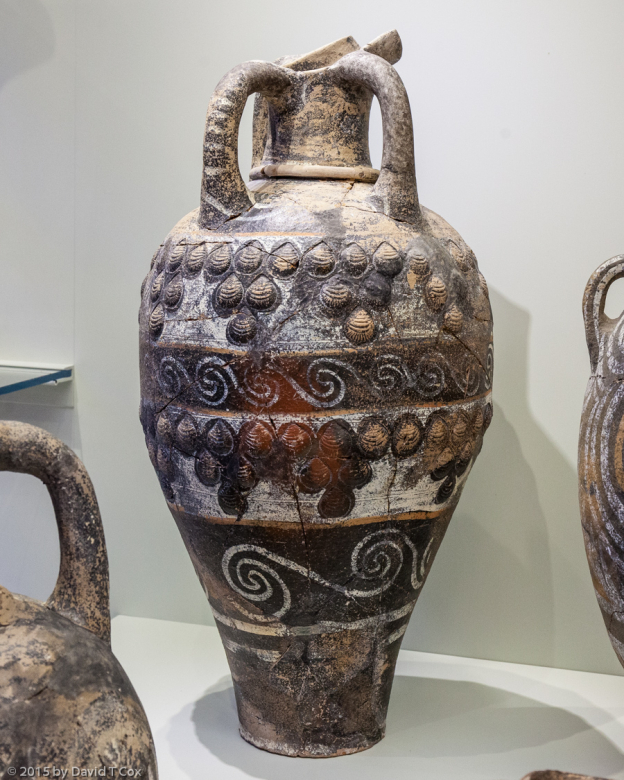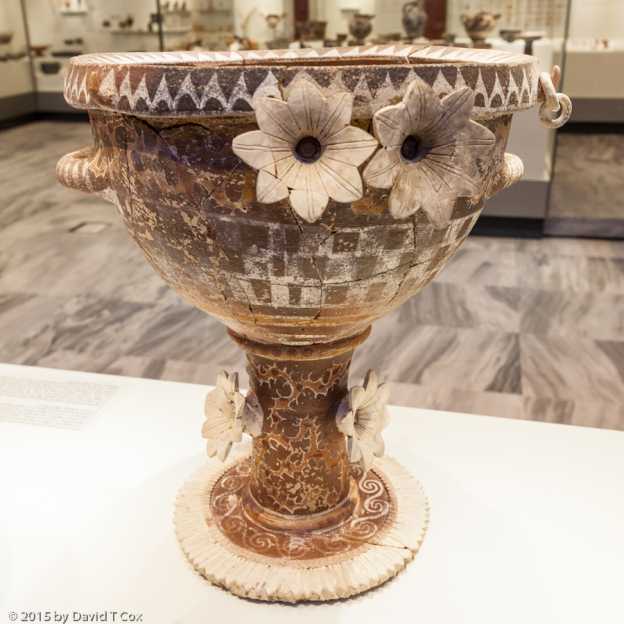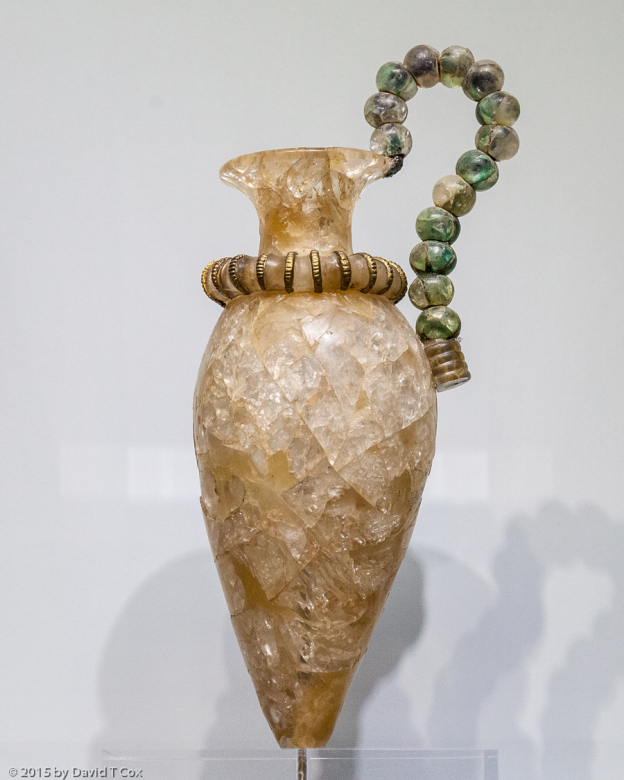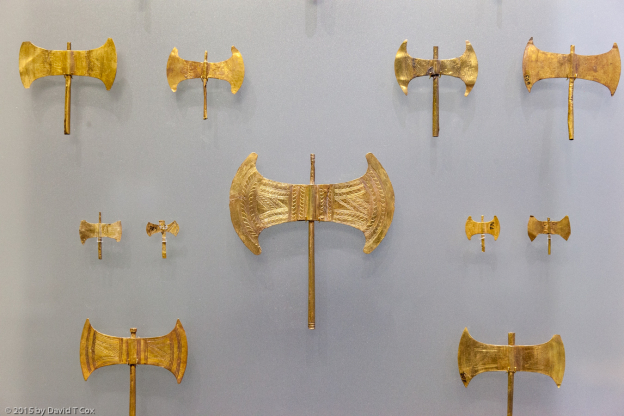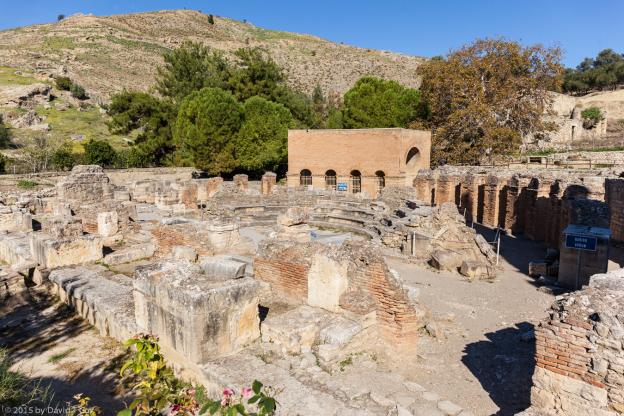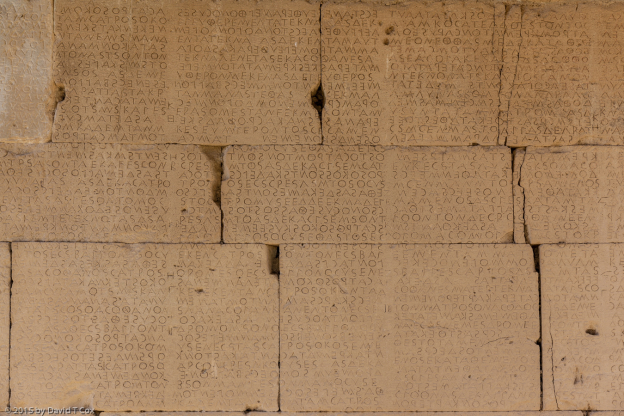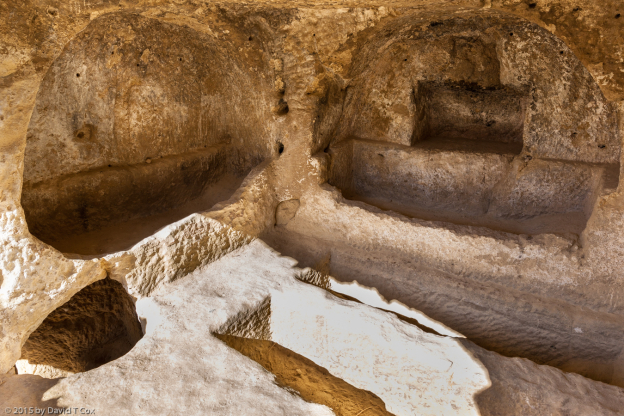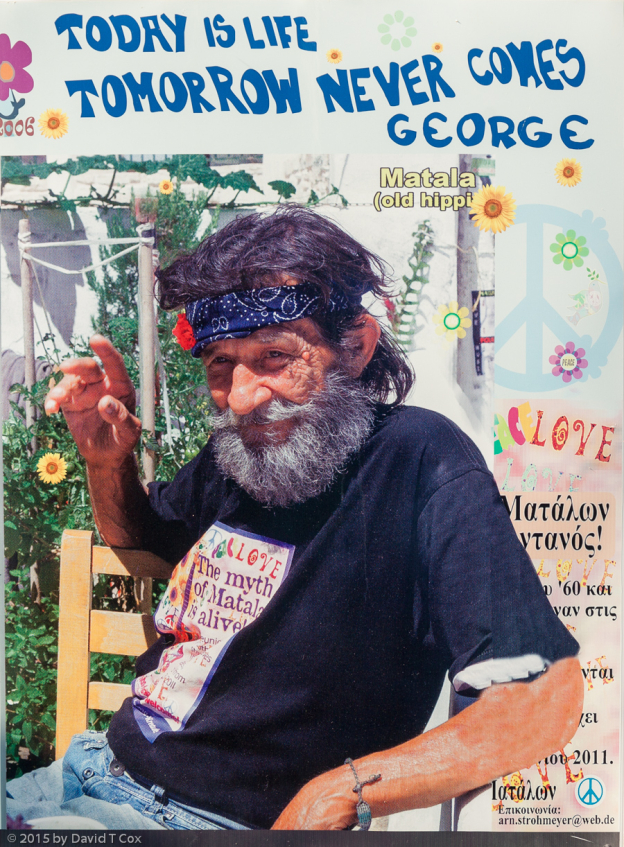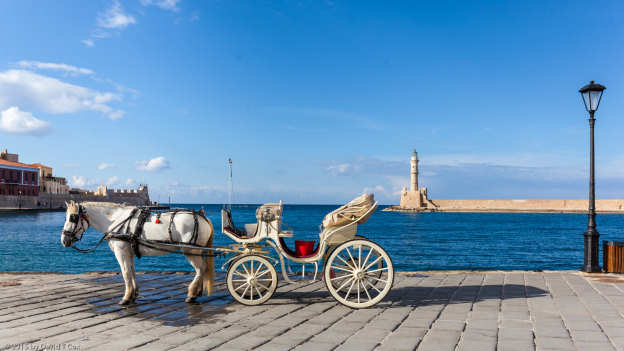All Photos Are Below the Travelogue Text
Click on Any Photo To Open Slide Show
To print the travelogue, right click anywhere on the page. Choose "Print" from your browser dialog box. You can choose Save to PDF in the browser print window.
Share your thoughts.
Email Dave - coxdavid55@hotmail.com
Hello all. I last reported from Old Town, Rhodes. On Nov. 10, I flew a small prop plane from Rhodes to Heraklion, capital of Crete, where I lodged in the Hotel Kronos overlooking the old Venetian Harbor on the north-central coast. The Old City part of Heraklion mostly still is surrounded by very thick Venetian fortress walls, built in the 13th century, and has the remnants of the Venetian ship-building structures around the old harbor. The major attractions for me were the Archaeology Museum, which houses all of the great artifacts of the Minoan civilization, and the most famous of the Minoan Palaces, Knossos, which lies just south of the present city.
I previously have written of the great Mycenaean culture, which produced the original flowering of Greek civilization on the mainland. Occurring roughly from the start of the 15th through the 12th centuries BC, the Mycenaean culture preceded the Greek Dark Ages. The Mycenaeans borrowed much of their culture, including styles of architecture, frescoes, pottery, metallurgy, religion and writing script, from the earlier Minoan civilization which grew without major antecedents on the island of Crete (the Minoans, of course, influenced and were influenced by the neighboring Egyptians, among others). Although present on Crete throughout the Bronze Age and before, the Minoans reached their cultural heights during the periods known as the First and the Second Palace Periods, which occurred from 1900-1700 BC and 1700-1450 BC, respectively. After the Second Palace Period, there appears to have been a blending or merging of Mycenaean and Minoan cultures, with perhaps Mycenaean occupation on Crete or Minoan occupation in the Peloponnese, or both.
Western civilization or European civilization has its roots in the Roman Empire, which in turn very heavily borrowed from and was influenced by Classical Greek civilization. The Classical Greeks were influenced, in religion and mythology, concepts of honor and heroism, as well as art and metallurgy by the preceding Mycenaean civilization, which itself adopted heavily from the Minoan civilization. Thus it is that the well-known historian Will Durant famously referred to the Minoans as “the first link in the European chain.” I feel, in tracing my own culture back through archaeological time, with the Minoans I have arrived at the beginning.
During the Minoan Palatial Periods, from about 1900 through 1200 BC, several great palace complexes, the centers of large urban populations, existed throughout the island of Crete (there were two major events of destruction followed by new construction, creating the distinction between the Old, the New and the Mono Palace Periods); the two perhaps most important Palaces were Knossos, just south of Heraklion, and Phaistos near the southern coast of Crete. Just a few kilometers west of Phaistos was the somewhat smaller Minoan palace of Agia Triada, referred to as a “villa.” Most of the great artifacts in the Heraklion Museum of Archaeology came from these three sites, and so these were, of course, on my “must visit” agenda. Knossos, the most famous, is claimed to be the palace of Homerian King Minos, and the minotaur jailed in its labyrinth. Knossos lies on a low hilltop just south of the north-central coast. It probably is not the best place to visit a “real” Minoan Palace, though it remains the major tourist attraction on the Island. It was excavated first at the end of the 19th century by Sir Arthur Evans, who, although he correctly extracted and deduced much of Minoan culture, and discovered many famous artifacts, unfortunately “reconstructed” many parts of the Palace stylistically under the influence of his “sense” of how 19th century European royalty would have used various parts of the buildings; the reconstructions are controversial, at best. This detracts from getting a decent and accurate overview of the ruins, as well as enclosing many of the most important rooms, thereby limiting access by tourists. Further, even now in the middle of low-season, great busloads of tours still arrive from the cruise ships docking daily in the Heraklion port.
Knossos produced many of the best artifacts to be seen in the Museum, and almost all of the discovered palace frescoes, the great wall paintings done on still-wet plastered surfaces. Most of the frescoes exist as fragments, which have been removed from the palace ruins and are reassembled in the Museum over panels which attempt to reproduce the missing portions, so the entirety of the scenes can be appreciated. I wonder at some of the reproductions of missing parts, but overall the frescoes are one of the huge highlights of Minoan art. I have included photos of the best of the restored frescoes, including the famous “bull-leaping” fresco (the Minoans had a number of different artistic representations of people using a charging bull’s horns to leap acrobatically over the top).
From Heraklion I traveled, Sunday a week ago, south across the island by bus, traversing the central mountain range, and dropping into the Messara Plains to the small town of Moires, situated centrally for the visitation of four target sites. Moires is not a tourist town, and is not mentioned in either of my guide books, nor in online research sites for hotels and restaurants. I found a hotel with a large relatively modern room, but plagued by mosquitos. I was not bothered, finally, on my last of four nights, after eradicating close to 2 dozen of the nuisances the previous 3 nights, using a fairly effective, rolled-up, damp hand towel to throw at them sitting high on the 11 foot bright yellow walls (successful “hits” were easily determined as most left behind a small bloody spot, establishing that each already had enjoyed my company). The first day in Moires the electric power went out for 8 hours, leaving many restaurants unable to serve customers. The next day the power was restored, but in the interim the town water supply stopped flowing, somehow related to the prior power outage and the pumps. Water was finally restored late afternoon allowing me my first shower in over 2 days of sweaty walking. The owner of my hotel stated this was the first time this had happened.
Phaistos Palace and Agia Triada “Villa” are both situated just west of Moires, and easily visited by hiring a taxi. At Agia Triada I was the sole visitor, and was informed by the gate keeper, who arrived half an hour after I did, that many days would have no visitors. Yet this was a most fascinating site, and source of many of the most famous Minoan and Minoan/Mycenaean artifacts. Because the site was not used by any later peoples after its collapse at the end of the Minoan occupation, and because the archaeologists wisely excavated and consolidated but did not “reconstruct” based on invalid assumptions, the site retains original walls, rooms, stairs and stone paved streets, as well as the many stone channel water delivery and sewage systems for which the Minoans are famous. I walked the 3 kilometers from Agia Triada around the side of the mountain to the site of Phaistos, a full Minoan Palace system. It, like Agia Triada, has been left relatively intact without annoying reconstruction, and I shared the site with perhaps only 4 other tourists. One of the more interesting features of the palaces is the large areas of “storage magazines,” rows of enclosed rooms built off of long corridors, which still contain huge pithoi, ceramic storage jars larger than barrels, where food stuffs apparently were kept.
Along with photos of the Minoan sites themselves, I have included a number of photos of the most famous artifacts, all of which reside in the Heraklion Museum. My favorite is the tiny gold “Bee Pendant” (from the Palace at Malia, which I did not visit) – it is a masterpiece of delicate jewelry design, said to combine all four types of gold metal working, and should appear on a computer monitor about 3 times its actual size of 4.5 cm. During the Old Palace Period (1900-1700 BC) the Minoans produced a famous and beautiful style of luxury pottery called Kamares ware, which is quite spectacular considering the age; I have included several photos. During the later New Palace Period the Minoans produced many fine ceramics displaying “Marine” style images, especially octopuses (I prefer the term “octopi,” but am informed that that form of plural has no etymological basis, although accepted in use), which wonderful creatures likenesses later were adopted copiously by the Mycenaeans on their ceramics. Also famous is the Phaistos Disk, a ceramic disk engraved on both sides with a still undeciphered hieroglyphic script which appears to travel circularly in a coil, though unclear whether to read from the center out or outside in. The spectacular solid limestone sarcophagus from Agia Triada, from the Mono-Palatial Period after the Mycenaean merger, completely is covered with painted scenes of funerary significance. Too much to absorb!
I spent one day visiting the ancient site of Gortyn, the Roman capital of Crete and northern Africa during the early centuries of the 1st Millennium. The ruins cover several square kilometers, spread through the most ancient olive trees I have ever seen; the city must have had a population of over 100,000. Although most of the ruins seen today date to the Roman Period, the city actually dates to the Archaic Period (about 700 BC), and contains the famous early 5th century BC stone wall inscribed with what today is called the Gortyn Law Code; only about 10% of the original remains, but still covers huge cut stones forming a curved wall of over 30 feet in length. My guide books state it contains such arcane rules as the requirement for the testimony of five men to convict a free man of a crime, but the testimony of one is sufficient to convict a slave.
On Wednesday the 18th I took a bus south to the tiny town of Matala, population a few dozen this time of year, but apparently receiving many thousands of visitors daily during tourist season. On the southern coast of Crete, the village sits above the beach in a pretty half moon bay facing west. On the north side of the bay is a cliff face of limestone, penetrated along its length by rock-cut Roman tombs (popularly referred to as caves), many having double and triple chambers, with benches for several bodies per chamber. In the late 1960s Matala attracted a large number of hippies, and was immortalized by Joni Mitchel who recorded a 1971 song (Carey) concerning her relationship while there. Internet sites claim Bob Dylan, Cat Stevens, Joan Baez and Janice Joplin all stayed there for a time, all claims almost certainly untrue, but, the hippie occupation was real. Many apparently took to free living quarters in the Roman tombs, until after some years the scandalized locals, led by the Bishop of Gortyn Province, had the squatters evicted. The Roman tombs now constitute a fenced off, and, thankfully, cleaned-up archaeological site, but the rest of the village is filled with rainbow colors and peace and love and flower-power signage on much of the commercial businesses. A short hike over the mountain to the south leads to another bay enclosing the Red Beach, reputed to be an infamous nude beach. I hiked up and over the mountain for scenic photos – not a living person anywhere on the trail or on Red Beach – one elderly couple, perhaps returned ex-hippies, on Matala Beach. The guide books state the tourists who visit in high season are aged hippies who claim to have spent time in the “caves” in the 60s and 70s. Who knew. I was, I guess, a hippie by all counts in the late 60s, and have no recollection of hearing of Matala, but then I was hardly at the center of everything that was “happening.”
On Thursday I returned to Heraklion, and spent hours the next day exploring again the Archaeology Museum; easier to navigate and understand now that I have seen the principal Minoan sites. On Saturday I traveled 3 hours by bus to the northwestern end of the island to the old city of Chania. The Old Town is surrounded by massive inner Byzantine and outer Venetian stone fortress walls. On the harbor, at the south-western corner of the walls, is the 400 year-old home converted to boutique Hotel Alcanea, where I now am staying. My window opens with a view out onto the harbor and the Venetian lighthouse built in 1600. The Old Town has the usual fascinating tiny passageways which penetrate maze-like in all directions though the ancient and sometimes crumbling buildings. Many little restaurants, seaside cafes and shops, most geared to the huge tourist influx during the “summer” season (April through October). Things are very quiet this time of year, though the weather has been beautiful.
I now have visited all of the places I had listed as must-see prior to arrival in Greece, plus a number of places I only learned of after arrival. I find I have about 12 extra days remaining before my previously purchased return flight to the US. Rather than returning to areas I already have passed through, I have decided to spend 12 days in Cyprus, never having visited before. I fly back to Athens tomorrow, and from there fly to Larnaka, Cyprus the following day. I have purchased a Kindle version of Lonely Planet’s guide to Cyprus, and am buried in reading through that book, and doing quick online research, to try and get the most out the side-trip. I will return to Athens for a couple of final days back at the Archaeology Museum, before returning to the US Dec. 9. Later. Dave
PS – I have noticed that many of the photo captions do not appear in the photo thumbnails as set forth directly below – PLEASE click on any photo to start the slideshow. In the slideshow the photos display larger and better, and all captions correctly display.
- Harbor and Venetian Fortress, Heraklion, Crete, Greece
- large Neolithic ceramic vessel, Knossos, 4500-3000 BC, Heraklion Archaeology Museum, Heraklion, Crete, Greece
- ceramic figurine of squatting woman associated w fertility, Pano Chorio, 5300-3000 BC, Heraklion Archaeology Museum, Heraklion, Crete, Greece
- The Minoan Gold Bee Pendant (4.6 cm), masterpiece of jewelry, Malia, 1800-1700 BC, Heraklion Archaeology Museum, Heraklion, Crete, Greece
- North Entrance & North Pillar Hall w Bull Fresco per Evans, Knossos Palace, Minoan, Crete, Greece
- The Bull-Leapiing Fresco, Minoan, Knossos, 1600-1400 BC, Heraklion Archaeology Museum, Heraklion, Crete, Greece
- fragment called “Cupbearer” of Procession Fresco, Minoan, Grand Staircase of Knossos Palace, 1500-1400 BC, Heraklion Archaeology Museum, Heraklion, Crete, Greece
- The “Snake Goddesses”, cult objects from Knossos temple repositories, Minoan, 1650-1550 BC, Heraklion Archaeology Museum, Heraklion, Crete, Greece
- stone bulls’ head rhyton, masterpiece of MInoan art, Knossos, 1600-1450 BC, Heraklion Archaeology Museum, Heraklion, Crete, Greece
- gold covered handles of swords, funerary goods from The Warrior Graves, Knossos Cemeteries, Minoan,1450-1300 BC, Heraklion Archaeology Museum, Heraklion, Crete, Greece
- The Ewer From Poros, Marine Style w shell relief, Knossos, Minoan, ca 1450 BC, Heraklion Archaeology Museum, Heraklion, Crete, Greece
- jewelry of gold, amethyst, faience, silver from Knossos Cemeteries, Minoan,1400-1300 BC, Heraklion Archaeology Museum, Heraklion, Crete, Greece
- Storage Pithoi Jars, Agia Triada Palace, Minoan, 1900-1450 BV, near Mires Crete, Greece
- paved stone road, Agia Triada Palace, Minoan, 1900-1450 BV, near Mires Crete, Greece
- The Harvester Vase, black steatite rhyton w reief of procession of men carrying harvesting implements, Minoan, Hagia Triada, 1450 BC, Heraklion Archaeology Museum, Heraklion, Crete, Greece
- The Hagia Triada Sarcophagus, limestone, Minoan MonoPalatial, 1350-1300 BC, Heraklion Archaeology Museum, Heraklion, Crete, Greece
- King’s Megaron, Festos Palace, Minoan, 1900-1450 BC, Crete, Greece
- West Magazines w Pithoi Storage Jars, Festos Palace, Minoan, 1900-1450 BC, Crete, Greece
- The Phaistos Disc w undeciphered script, Minoan, Phaistos, early 17th C BC, Heraklion Archaeology Museum, Heraklion, Crete, Greece
- early Minoan Kamares ware vessel, Palaces of Phaistos, 1900-1800 BC, Heraklion Archaeology Museum, Heraklion, Crete, Greece
- luxury Minaon Kamares ware ewer, decorated w applied seashells, Phaistos, 1800-1700 BC, Heraklion Archaeology Museum, Heraklion, Crete, Greece
- luxury Minoan Kamares ware for banquets, Phaistos, 1800-1700 BC, Heraklion Archaeology Museum, Heraklion, Crete, Greece
- luxury rock crystal rhyton from The Treasury of the Shrine at Zakros, Minoan, 1500-1450 BC, Heraklion Archaeology Museum, Heraklion, Crete, Greece
- clay vessel in “Marine Style”, Minoan, 1500-1450 BC, Heraklion Archaeology Museum, Heraklion, Crete, Greece
- gold votive double axes, Minoan, Arkalochori Cave, 1700-1450 BC, Heraklion Archaeology Museum, Heraklion, Crete, Greece
- Odeon, 2nd C AD, Roman, Gortys, Crete, Greece
- Gortys Law Code engraved Wall, 6th C BC, Gortys, Crete, Greece
- Matala Pano 3, Matala, Crete, Greece
- Roman Rock-Cut Tombs, Matala, Crete, Greece
- Poster at Matala, Crete, Greece
- Venetian Lighthouse & horse carriage, 1595-1601, Chania, Crete, Greece
To print the travelogue, right click anywhere on the page. Choose "Print" from your browser dialog box. You can choose Save to PDF in the browser print window.
Share your thoughts.
Email Dave - coxdavid55@hotmail.com
